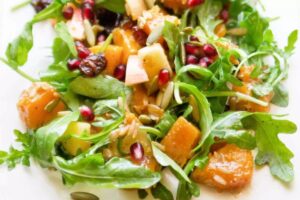
Transitioning to a raw vegan lifestyle can be a transformative journey towards better health and overall well-being. By embracing this plant-based approach, you’ll nourish your body with nutrient-dense, unprocessed foods that provide optimal vitality. In this comprehensive guide, we’ll explore the essential steps and strategies to help you start a raw vegan lifestyle successfully. Whether you’re a beginner or someone looking to enhance your existing raw vegan practices, this guide has got you covered.
What Is the Raw Food Diet?
The raw food diet is a dietary approach that focuses on consuming primarily uncooked and unprocessed foods. It is based on the belief that cooking food can destroy vital enzymes and nutrients, leading to a loss of nutritional value. Advocates of the raw food diet argue that consuming foods in their natural, raw state provides maximum health benefits.
The raw food diet typically consists of fresh fruits, vegetables, nuts, seeds, and sprouted grains. These foods are often consumed raw, although some variations of the diet allow for minimal cooking at low temperatures. The diet emphasizes whole, plant-based foods and excludes processed or refined foods, dairy products, and animal-derived foods.
Raw food enthusiasts believe that this way of eating promotes optimal health and vitality. They claim that a raw food diet can increase energy levels, improve digestion, enhance skin health, aid in weight management, and reduce the risk of certain chronic diseases.
It’s important to note that the raw food diet requires careful planning to ensure adequate nutrient intake. While fruits and vegetables are rich in vitamins, minerals, and fiber, certain nutrients like vitamin B12, iron, and omega-3 fatty acids may be challenging to obtain solely from raw plant-based sources. Therefore, individuals following a raw food diet should pay attention to their nutrient intake and consider consulting with a healthcare professional or registered dietitian to ensure they meet their nutritional needs.
Overall, the raw food diet is a lifestyle choice that emphasizes the consumption of uncooked, plant-based foods. It offers a unique approach to nutrition and can be a suitable option for individuals seeking a natural and minimally processed way of eating.
What can you eat on a raw food diet?
On a raw food diet, you can enjoy a wide variety of fresh, uncooked, and unprocessed foods. Here are some examples of foods commonly included in a raw food diet:
- Fruits: Include a variety of fresh fruits such as apples, bananas, berries, oranges, mangoes, and melons. These provide natural sweetness, fiber, and a range of vitamins and minerals.
- Vegetables: Consume an assortment of raw vegetables like leafy greens (spinach, kale, lettuce), cucumbers, carrots, bell peppers, broccoli, cauliflower, and zucchini. These vegetables are packed with nutrients, including vitamins, minerals, and antioxidants.
- Nuts and Seeds: Incorporate raw nuts and seeds into your diet, such as almonds, walnuts, cashews, chia seeds, flaxseeds, and pumpkin seeds. These provide healthy fats, protein, and essential minerals.
- Sprouted Grains and Legumes: Sprouted grains like quinoa, buckwheat, and brown rice, as well as sprouted legumes like lentils and chickpeas, can be included for added variety and nutrients.
- Raw Dairy Alternatives: If you choose to include dairy alternatives, opt for raw and plant-based options like almond milk, cashew cheese, and coconut yogurt.
- Cold-Pressed Oils: Use cold-pressed oils in moderation, such as extra virgin olive oil, coconut oil, and avocado oil. These can be drizzled over salads or used in raw food recipes.
- Seaweeds: Add mineral-rich seaweeds like nori, dulse, and kelp to your diet. These can be incorporated into salads or used as wraps for raw sushi rolls.
- Superfoods: Include nutrient-dense superfoods like spirulina, chlorella, wheatgrass, maca powder, and cacao nibs. These offer additional antioxidants, vitamins, and minerals.
- Raw Fermented Foods: Incorporate fermented foods like sauerkraut, kimchi, and kombucha, which are rich in beneficial bacteria for gut health.
It’s important to note that while the raw food diet focuses on uncooked foods, some variations allow for minimal cooking at low temperatures. However, the majority of the diet consists of raw, plant-based foods to maximize nutritional benefits.
Remember, it’s essential to ensure you’re meeting your nutritional needs on a raw food diet. Pay attention to your intake of essential nutrients like protein, iron, calcium, and vitamin B12. Consider working with a registered dietitian or healthcare professional to develop a well-balanced meal plan that supports your health and well-being.
Foods to avoid as a raw vegan
As a raw vegan, there are several types of foods to avoid to adhere to the principles of this dietary lifestyle. Since the raw vegan diet emphasizes the consumption of uncooked and unprocessed plant-based foods, the following categories of foods are typically excluded:
- Cooked Foods: The primary principle of the raw vegan diet is to consume foods in their raw, natural state. This means avoiding all cooked foods, including cooked vegetables, grains, legumes, and animal-derived foods.
- Processed Foods: Stay away from processed foods, such as packaged snacks, canned goods, and processed desserts, as they often contain additives, preservatives, and high levels of sodium and refined sugars.
- Meat and Animal Products: Raw vegans avoid all forms of meat, poultry, fish, eggs, and dairy products, as they are derived from animals and usually cooked before consumption.
- Refined Sugar: Processed and refined sugars are excluded from the raw vegan diet. Instead, natural sweeteners like dates, maple syrup, and agave nectar may be used in moderation.
- Refined Grains and Flours: Refined grains and flours lack essential nutrients and fiber. Therefore, raw vegans avoid foods like white rice, white flour, and pasta.
- Fried Foods: Since frying involves cooking at high temperatures, fried foods are not part of the raw vegan diet.
- Processed Oils: Refined and processed oils are excluded. Raw vegans prefer using cold-pressed oils in moderation for their healthy fats.
- Pasteurized Juices: Raw vegans prefer fresh, raw fruit and vegetable juices rather than pasteurized versions, as pasteurization involves heating.
- Coffee and Black Tea: Both coffee and black tea are heated beverages and are not part of the raw vegan diet. Herbal teas and other raw beverages are preferred.
- Foods Containing Artificial Additives: Avoid foods that contain artificial additives, flavors, and colors. Opt for natural and whole ingredients instead.
Remember, the raw vegan diet is based on the belief that uncooked and unprocessed foods provide optimal health benefits. By excluding certain foods and embracing a plant-based, raw food lifestyle, individuals can nourish their bodies with nutrient-dense, living foods that support overall well-being.
Is raw food healthier than cooked food?
The debate between the health benefits of raw food versus cooked food is a topic of discussion among nutrition experts. Both raw and cooked foods have their own advantages and potential drawbacks, and the overall healthiness depends on various factors.
Raw Food:
- Nutrient Retention: Raw foods, particularly fruits and vegetables, are rich in vitamins, minerals, and enzymes. Some nutrients, such as vitamin C and certain B vitamins, can be partially lost during cooking. Therefore, consuming raw fruits and vegetables may provide a higher concentration of these heat-sensitive nutrients.
- Enzymes: Raw foods contain natural enzymes that can aid in digestion and support overall gut health. Cooking can denature enzymes, so consuming raw foods may provide a more abundant supply of these beneficial compounds.
- Hydration: Raw fruits and vegetables have high water content, contributing to hydration. Juicing raw fruits and vegetables can provide a hydrating and nutrient-dense beverage.
- Fiber: Raw foods are typically rich in dietary fiber, which promotes digestive health, helps regulate blood sugar levels, and contributes to satiety.
Cooked Food:
- Improved Nutrient Accessibility: Cooking can enhance the availability and absorption of certain nutrients. For example, the heat from cooking can break down cell walls, making nutrients like lycopene in tomatoes and beta-carotene in carrots more accessible to the body.
- Food Safety: Cooking helps kill harmful bacteria, parasites, and other pathogens that may be present in raw foods. This reduces the risk of foodborne illnesses.
- Palatability and Variety: Cooking can enhance the flavors, aromas, and textures of foods, making them more appealing and enjoyable to eat. It also expands the range of culinary options and increases the variety of nutrients that can be obtained from different cooked foods.
- Digestion and Energy Conservation: Cooking breaks down complex carbohydrates and proteins, making them easier to digest. This process can save energy that would otherwise be spent on breaking down raw foods.
Both raw and cooked foods have their benefits. Consuming a combination of raw and cooked foods can provide a well-rounded and balanced diet. It’s important to consider individual preferences, digestive health, and the specific nutritional needs of each person. Consulting with a registered dietitian or healthcare professional can help determine the best approach to meet your unique dietary goals and requirements.
How to Start a Raw Vegan Lifestyle
Embarking on a raw vegan lifestyle requires careful planning and preparation. Follow these steps to make a smooth transition:
Step 1: Educate Yourself on Raw Veganism
Before diving into the raw vegan lifestyle, it’s crucial to gain a solid understanding of its principles, benefits, and potential challenges. Educate yourself on the nutritional aspects of raw veganism, explore recipe ideas, and familiarize yourself with common ingredients. This knowledge will empower you to make informed choices and set realistic expectations.
Step 2: Gradual Transition
Rather than making an abrupt change, consider transitioning gradually to a raw vegan lifestyle. Start by incorporating more raw fruits, vegetables, nuts, and seeds into your daily meals. This approach allows your body to adapt gradually and helps prevent any potential discomfort during the transition phase.
Step 3: Stock Your Kitchen
To ensure success, it’s essential to stock your kitchen with a wide variety of raw vegan ingredients. Fill your pantry with fresh produce, such as leafy greens, berries, and citrus fruits. Additionally, include nuts, seeds, sprouted grains, and legumes to diversify your nutrient intake. Having a well-stocked kitchen will make it easier to create delicious and satisfying raw vegan meals.
Step 4: Experiment with Recipes
Exploring new recipes is a delightful way to embrace a raw vegan lifestyle. Look for creative and flavorful dishes that incorporate raw ingredients. Experiment with smoothie bowls, raw salads, zucchini noodles, and dehydrated snacks. Online resources, recipe books, and raw vegan communities can provide inspiration and support along your culinary journey.
Step 5: Stay Hydrated
Hydration is essential in any healthy lifestyle, including raw veganism. Make sure to drink an adequate amount of water throughout the day to support digestion, nutrient absorption, and overall well-being. You can also enjoy hydrating options like herbal teas, infused water, and fresh juices to keep your body nourished and refreshed.
Step 6: Practice Mindful Eating
Adopting a raw vegan lifestyle goes beyond dietary choices; it’s also about fostering a mindful eating practice. Slow down during meals, savor the flavors, and pay attention to your body’s hunger and satiety cues. Engage all your senses while enjoying your food, and cultivate gratitude for the nourishment it provides.
Step 7: Seek Support and Community
Transitioning to a raw vegan lifestyle can be more manageable and enjoyable when you connect with like-minded individuals. Seek support from online communities, attend local events, and engage in discussions with fellow raw vegans. Sharing experiences, recipes, and challenges can provide encouragement and valuable insights throughout your journey.
FAQs About Starting a Raw Vegan Lifestyle
Will I get enough protein on a raw vegan diet?
Yes, a well-planned raw vegan diet can provide an adequate amount of protein. Incorporate plant-based protein sources such as nuts, seeds, legumes, and sprouted grains into your meals. You can also explore protein-rich superfoods like spirulina and hemp seeds.
Can I eat cooked food occasionally on a raw vegan lifestyle?
While the raw vegan lifestyle primarily emphasizes consuming uncooked foods, occasional consumption of lightly cooked or steamed vegetables is acceptable for some individuals. However, it’s important to prioritize raw, plant-based foods to maximize the benefits.
What are the potential health benefits of a raw vegan lifestyle?
Adopting a raw vegan lifestyle can offer numerous health benefits, including increased energy levels, improved digestion, enhanced skin health, weight management, and reduced risk of chronic diseases like heart disease and diabetes.
How can I ensure I’m getting all the necessary nutrients?
To ensure you’re meeting your nutritional needs, focus on consuming a diverse range of fruits, vegetables, nuts, seeds, and sprouted grains. Consider working with a registered dietitian or nutritionist who specializes in raw vegan diets to create a well-balanced meal plan.
What are some common challenges when starting a raw vegan lifestyle?
Common challenges when starting a raw vegan lifestyle include finding appropriate food options while dining out, adapting to new tastes and textures, and managing social situations that involve non-raw vegan food. Planning ahead, seeking support, and maintaining a positive mindset can help overcome these challenges.
Can a raw vegan lifestyle be suitable for children and pregnant women?
A raw vegan lifestyle can be suitable for children and pregnant women; however, it requires extra attention to ensure sufficient nutrient intake. Consult with a healthcare professional or registered dietitian to develop a well-rounded meal plan tailored to the specific needs of children and pregnant women.
Conclusion
Embarking on a raw vegan lifestyle is a profound choice that can positively impact your health, the environment, and animal welfare. By following the steps outlined in this comprehensive guide, you can start your journey with confidence and enjoy the abundant benefits of a raw vegan lifestyle. Remember to seek support, stay curious, and embrace the culinary adventure that awaits you.






